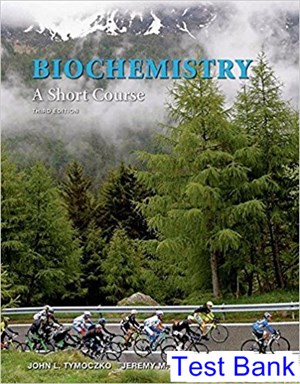Instant download Biochemistry A Short Course 3rd Edition Tymoczko Test Bank pdf docx epub after payment.

Product details:
- ISBN-10 : 1464126135
- ISBN-13 : 978-1464126130
- Author: Jeremy M. Berg; John L. Tymoczko
Derived from the classic text originated by Lubert Stryer and continued by John Tymoczko and Jeremy Berg, Biochemistry: A Short Course focuses on the major topics taught in a one-semester biochemistry course. With its short chapters and relevant examples, it’s uniquely effective in helping students see the connections between the biochemistry they’re studying and their own lives.
This new edition takes into account recent discoveries and advances that have changed how we think about the fundamental concepts in biochemistry and human health. A number of new interactive features are designed to help instructors create a more active environment in the classroom. Those new resources are found in LaunchPad, the third edition’s dedicated version of W.H. Freeman’s breakthrough online course space.
Table Of Contents:
PART I: THE MOLECULAR DESIGN OF LIFE
Section 1: Biochemistry
Chapter 1: Biochemistry and the Unity of Life
Chapter 2: Water, Weak Bonds and the Generation of Order Out of Chaos
Section 2: Protein Composition and Structure
Chapter 3: Amino Acids
Chapter 4: Protein Three-Dimensional Structure
Chapter 5: Techniques in Protein Biochemistry
Section 3: Basic Concepts and Kinetics of Enzymes
Chapter 6: Basic Concepts of Enzyme Action
Chapter 7: Kinetics and Regulation
Chapter 8: Mechanisms and Inhibitors
Chapter 9: Hemoglobin, An Allosteric Protein
Section 4: Carbohydrates and Lipids
Chapter 10: Carbohydrates
Chapter 11: Lipids
Section 5: Cell Membranes, Channels, Pumps and Receptors
Chapter 12: Membrane Structure and Function
Chapter 13: Signal-Transduction Pathways
PART II: TRANSDUCING AND STORING ENERGY
Section 6: Basic Concepts and Design of Metabolism
Chapter 14: Digestion: Turning a Meal into Cellular Biochemicals
Chapter 15: Metabolism: Basic Concepts and Design
Section 7: Glycolysis and Gluconeogenesis
Chapter 16: Glycolysis
Chapter 17: Gluconeogenesis
Section 8: The Citric Acid Cycle
Chapter 18: Preparation for the cycle
Chapter 19: Harvesting electrons from the cycle
Section 9: Oxidative Phosphorylation
Chapter 20: The Electron-Transport Chain
Chapter 21: The Proton-Motive Force
Section 10: The Light Reactions of Photosynthesis and the Calvin Cycle
Chapter 22: The Light Reactions
Chapter 23: The Calvin Cycle
Section 11: Glycogen Metabolism and the Pentose Phosphate Pathway
Chapter 24: Glycogen Degradation
Chapter 25: Glycogen Synthesis
Chapter 26: The Pentose Phosphate Pathway
Section 12: Fatty Acid and Lipid Metabolism
Chapter 27: Fatty Acid Degradation
Chapter 28: Fatty Acid Synthesis
Chapter 29: Lipid Synthesis: Storage Lipids, Phospholipids, and Cholesterol
Section 13: The Metabolism of Nitrogen-Containing Molecules
Chapter 30: Amino Acid Degradation and the Urea Cycle
Chapter 31: Amino Acid Synthesis
Chapter 32: Nucleotide Metabolism
PART III: SYNTHESIZING THE MOLECULES OF LIFE
Section 14: Nucleic Acid Structure and DNA Replication
Chapter 33: The Structure of Informational Macromolecules: DNA and RNA
Chapter 34: DNA Replication
Chapter 35: DNA Repair and Recombination
Section 15: RNA Synthesis, Processing and Regulation
Chapter 36: RNA Synthesis and Regulation in Bacteria
Chapter 37: Gene Expression in Eukaryotes
Chapter 38: RNA Processing in Eukaryotes
Section 16: Protein Synthesis and Recombinant DNA Techniques
Chapter 39: The Genetic Code
Chapter 40: The Mechanism of Protein Synthesis
Chapter 41: Recombinant DNA Techniques





